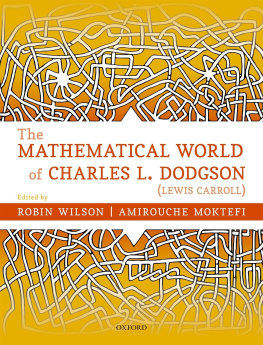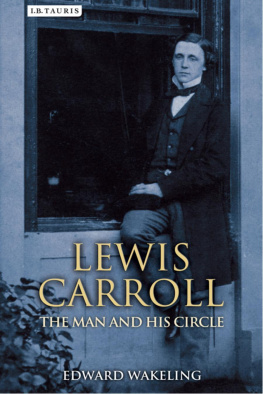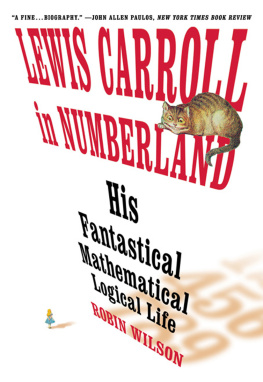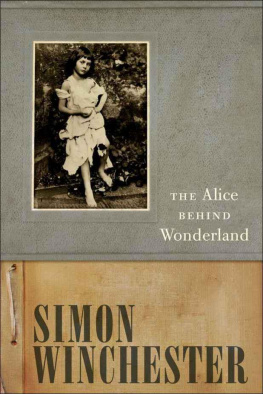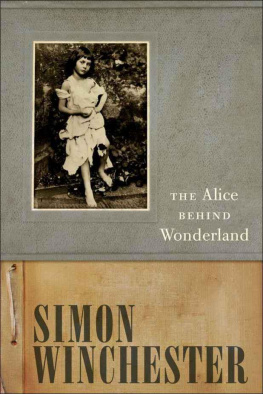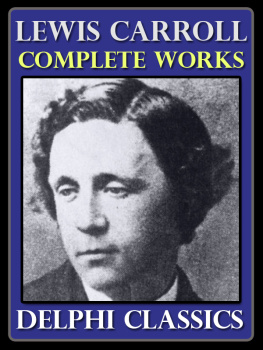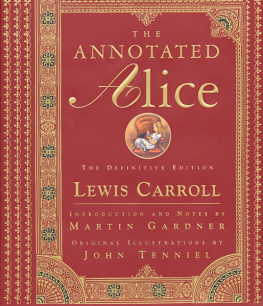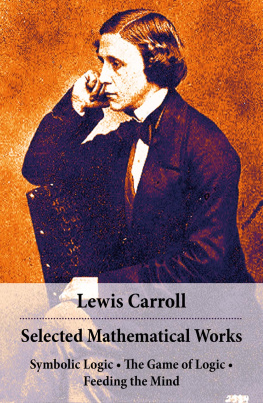The Mathematical World of Charles L. Dodgson (Lewis Carroll)
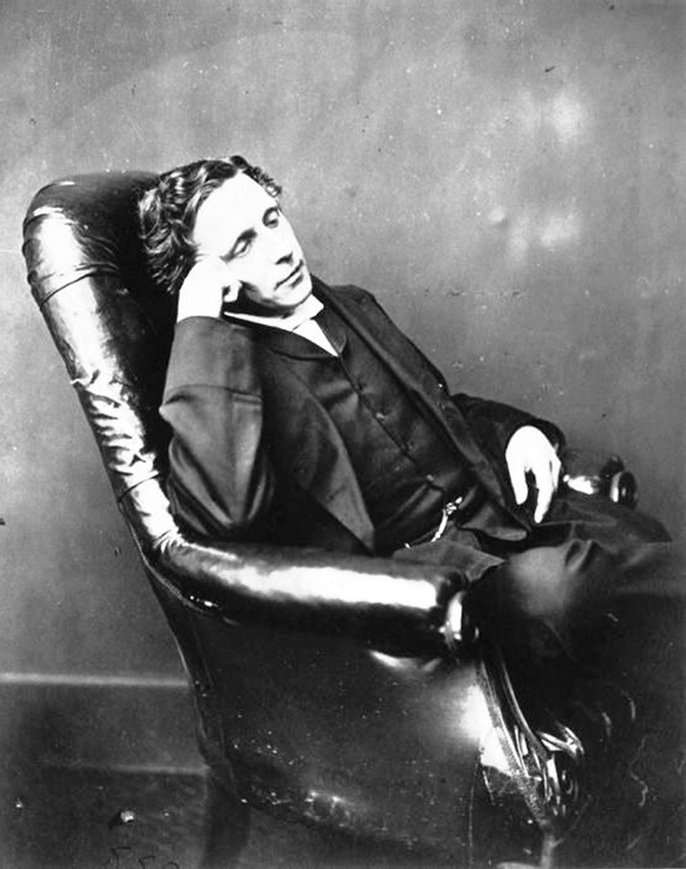
Charles Lutwidge Dodgson (18321898)
[Courtesy of Edward Wakeling]

Great Clarendon Street, Oxford, OX2 6DP, United Kingdom
Oxford University Press is a department of the University of Oxford. It furthers the Universitys objective of excellence in research, scholarship, and education by publishing worldwide. Oxford is a registered trade mark of Oxford University Press in the UK and in certain other countries
Robin Wilson and Amirouche Moktefi 2019
The moral rights of the authors have been asserted
First Edition published in 2019
Impression: 1
All rights reserved. No part of this publication may be reproduced, stored in a retrieval system, or transmitted, in any form or by any means, without the prior permission in writing of Oxford University Press, or as expressly permitted by law, by licence or under terms agreed with the appropriate reprographics rights organization. Enquiries concerning reproduction outside the scope of the above should be sent to the Rights Department, Oxford University Press, at the address above
You must not circulate this work in any other form and you must impose this same condition on any acquirer
Published in the United States of America by Oxford University Press 198 Madison Avenue, New York, NY 10016, United States of America
British Library Cataloguing in Publication Data
Data available
Library of Congress Control Number: 2018961475
ISBN 9780198817000
ebook ISBN 9780192549020
DOI: 10.1093/oso/9780198817000.001.0001
Printed and bound by CPI Group (UK) Ltd, Croydon, CR0 4YY
Links to third party websites are provided by Oxford in good faith and for information only. Oxford disclaims any responsibility for the materials contained in any third party website referenced in this work.
Contents
Scholarship on Charles Lutwidge Dodgson has long focused on his literary works, and specifically on the Alice tales, Alices Adventures in Wonderland and Through the Looking-Glass. Theories have abounded on Dodgsons dual personality: the fantastic novelist on the one hand and the dull mathematician on the other. The latter was generally ignored, or even dismissed, except for specific occasions such as the 1932 centenary of his birth which witnessed the publication of a few commentaries on Dodgsons mathematics, notably by R. B. Braithwaite and D. B. Eperson. Yet, Dodgson was first and foremost studied as the man who wrote Alice.
The situation progressively changed in the mid-20th century. This was stimulated by, among other reasons, the abridged edition of Dodgsons diaries in 1953, the new editions of some of Dodgsons mathematical works by Dover Publications in 1958 and later, and the appearance of serious studies by Helmut Gersheim on Dodgsons photography and Duncan Black on Dodgsons political papers. These studies contributed to shifting Dodgsons image towards a unique yet multifaceted character with numerous interests. Although the novelist continued to dominate scholarship, studies on Dodgsons mathematics and photography episodically appeared. In 1954 Warren Weaver produced the first description of Dodgsons mathematical Nachlass.
This revival of Dodgson studies was accentuated in the 1960s, and more decisively in the 1970s, with the publication of Martin Gardners Annotated Alice in 1960 and the foundation of Lewis Carroll Societies in Britain (1969) and North America (1974). These societies (and others) gave scholars opportunities to meet regularly and to publish their findings in the societies journals and other publications. Studies on Dodgsons mathematics began to appear on a regular basis.
By the 1980s it had become evident that Dodgsons studies were no longer exclusively Carrollian. This was seen in the larger space devoted to Dodgsons mathematics in the new biographies, in collections of essays, and finally in meetings and occasional celebrations. Significant studies were published by Tony Beale, William Warren Bartley, III, Ernest Coumet, Edward Wakeling, George Englebretsen, Eugene Seneta, Iain McLean, Mark R. Richards, Francine F. Abeles, and others. Dodgsons mathematics became a serious academic subject for historians of mathematics.
In the early 1990s two major editorial projects were initiated, supported by the Carrollian societies. These projects were rightly expected to make a significant impact on Dodgson scholarship in general, and on the study of his mathematical activities in particular. First, Edward Wakeling engaged in editing an unabridged version of Dodgsons diaries, thus restoring the mathematical entries that had been largely omitted from earlier editions. A series of collections of Dodgsons pamphlets was then projected, of which five volumes have so far appeared, under the editorship of Edward Wakeling (on Oxford affairs), Francine Abeles (mathematics, political issues, and logic), and Christopher Morgan (games and puzzles). There is no doubt that these publications have stimulated further research into several areas of Dodgson scholarship, and notably on his mathematics.
In the 21st century it has not been unusual to encounter studies on Dodgsons mathematics at international conferences or in academic journals. Previously unknown sources have been revealed, novel results have been discovered, and new scholars have investigated a range of Dodgsons mathematical activities. In recent years, specific meetings have even been devoted entirely to Dodgsons mathematics, and ensuing collections of essays have been published. In 2008 one of us wrote the first mathematical biography of Dodgson, aiming to fill a need that had long been felt, and to make accessible to a wide audience a large amount of information that had hitherto been unreachable.
The present volume might be viewed as a culmination of this long line of work. It gathers the best authorities on Dodgsons mathematics in their areas of expertise. It reveals Dodgson as a regular, obtuse, and imaginative mathematical researcher. His interests cover a variety of mathematical disciplines. He addressed problems that may be viewed as highly abstract, but also investigated topics that would rather be ranked among applied mathematics. Finally, it depicts someone who shared many of the concerns of his contemporary British mathematicians but was less familiar with (although not totally ignorant of) the progress that was being made on the Continent. It may be said of Dodgson that he truly was a Victorian mathematician.
We wish to express our gratitude to the many people who have helped us in the preparation of this book. In particular, we should like to thank all the contributors to this book for their patience, during the editing process, in coping with our many whims and requests. In particular, we are very grateful to Edward Wakeling for suggesting and providing many of the pictorial images in this volume from his magnificent archive collection. On the publication side, we should like to thank Daniel Taber and Katherine Ward of Oxford University Press and Lydia Shinoj of SPi Global for all their help and encouragement.
Robin Wilson and Amirouche Moktefi
June 2018
This is not a full list of Charles Dodgsons activities, but contains the main events in his life and his most important mathematical (and other) publications; several titles are abbreviated.

